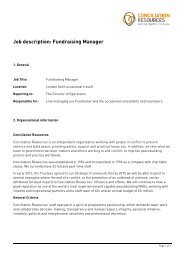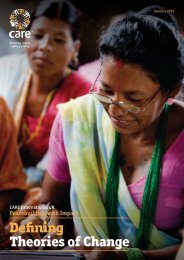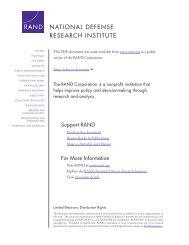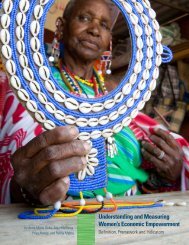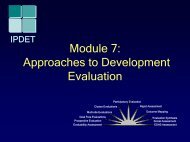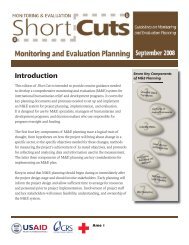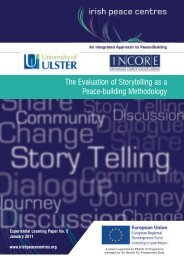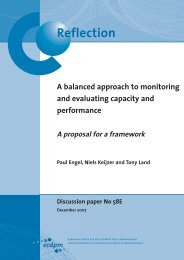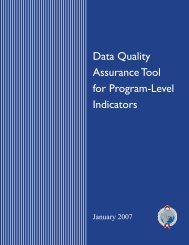Measuring Achievements of Private Sector Development in ... - DCED
Measuring Achievements of Private Sector Development in ... - DCED
Measuring Achievements of Private Sector Development in ... - DCED
You also want an ePaper? Increase the reach of your titles
YUMPU automatically turns print PDFs into web optimized ePapers that Google loves.
<strong>Measur<strong>in</strong>g</strong> <strong>Achievements</strong> <strong>of</strong> <strong>Private</strong> <strong>Sector</strong> <strong>Development</strong> <strong>in</strong> Conflict-Affected Environments<br />
1.1.1.3 Consider<strong>in</strong>g potential negative effects <strong>of</strong> conflict through results cha<strong>in</strong>s<br />
In addition to exam<strong>in</strong><strong>in</strong>g a project’s positive or negative impacts on conflict, it is also important to<br />
consider the conflict’s potential impact on project activities. These may <strong>in</strong>clude:<br />
Direct attacks on or threats to staff members or the project, limit<strong>in</strong>g their potential for engagement<br />
Beneficiaries chose not to participate <strong>in</strong> the project, because they do not see it as neutral or do not<br />
consider it safe to do so<br />
Inability to access project location, h<strong>in</strong>der<strong>in</strong>g implementation and monitor<strong>in</strong>g<br />
Project assets stolen by warr<strong>in</strong>g groups<br />
Initial project design rendered irrelevant by <strong>in</strong>tensification <strong>of</strong> conflict (e.g. project beneficiaries are<br />
forced to move)<br />
Such risks to project performance can be <strong>in</strong>corporated with<strong>in</strong> the risks and assumptions section <strong>of</strong> your<br />
project design documents. Once identified, they should <strong>in</strong>form the choice <strong>of</strong> project <strong>in</strong>terventions and<br />
strategies to mitigate their impacts.<br />
1.1.2 Incorporat<strong>in</strong>g Peacebuild<strong>in</strong>g <strong>in</strong>to PSD<br />
Conflict is <strong>of</strong>ten driven by economic factors 23 , and so PSD may play a critical role <strong>in</strong> creat<strong>in</strong>g the<br />
conditions for a stable society. It can address the causes or escalat<strong>in</strong>g factors <strong>of</strong> conflict, such as<br />
unemployment or poverty. It can also support peacebuild<strong>in</strong>g and reconciliation processes, for example<br />
by support<strong>in</strong>g the bus<strong>in</strong>ess community to negotiate between different parties to the conflict.<br />
Projects may consequently wish to build their programme logic around contribut<strong>in</strong>g to peacebuild<strong>in</strong>g.<br />
However, not all projects should try to capture their impact on conflict, as this requires adequate staff<br />
capacity, time, and fund<strong>in</strong>g. Few PSD projects have thus far been able to do so effectively. With<br />
sufficient resources, however, it is a very valuable project outcome to monitor.<br />
If projects did wish to capture their impact on stability, they should first outl<strong>in</strong>e their theory <strong>of</strong> change,<br />
or results cha<strong>in</strong>, expla<strong>in</strong><strong>in</strong>g how they expect to have a positive impact on the conflict. This should be<br />
rooted <strong>in</strong> the conflict analysis, and aim to address the identified drivers <strong>of</strong> conflict. To <strong>in</strong>form the<br />
development <strong>of</strong> peacebuild<strong>in</strong>g results cha<strong>in</strong>s, consider the follow<strong>in</strong>g list, which presents several <strong>of</strong> the<br />
most recognized ways <strong>in</strong> which PSD can contribute to peacebuild<strong>in</strong>g. 24 In practice, results cha<strong>in</strong>s are<br />
likely to be far more complex than these examples, with multiple levels and branches. For one example,<br />
see the <strong>DCED</strong> case study <strong>of</strong> GIZ <strong>in</strong> Sierra Leone.<br />
23 Love, Roy, Economic Drivers <strong>of</strong> Conflict and Cooperation <strong>in</strong> the Horn <strong>of</strong> Africa: A Regional Perspective and<br />
Overview, 2009.<br />
24 Drawn and adapted from The Donor Committee for Enterprise <strong>Development</strong>, <strong>Private</strong> <strong>Sector</strong> <strong>Development</strong> <strong>in</strong><br />
Conflict-Affected Environments – A Framework <strong>of</strong> Peacebuild<strong>in</strong>g Impacts, 2010; Rachel Goldwyn, Livelihoods and<br />
Peacebuild<strong>in</strong>g – what are current approaches to contribut<strong>in</strong>g to peacebuild<strong>in</strong>g through livelihoods <strong>in</strong>terventions<br />
(unpublished); Church, Cheyanne and Mark M. Roberts, Design<strong>in</strong>g for Results: Integrat<strong>in</strong>g M&E <strong>in</strong> Conflict<br />
Transformation Programmes, 2006; Mercy Corps. Evaluation and Assessment <strong>of</strong> Poverty and Conflict<br />
Interventions. Conflict & Economics: Lessons Learned on <strong>Measur<strong>in</strong>g</strong> Impact. Undated.<br />
Practical Guidel<strong>in</strong>es for Implement<strong>in</strong>g the <strong>DCED</strong> Standard. Version 2, July 2013<br />
14



